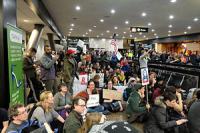-
Trump’s “Muslim ban” produced rare shift in public opinion: Study

President Donald Trump signed Executive Order 13769 on 27 January 2017, effectively barring individuals from seven predominately Muslim countries from entering the United States for ninety days. Within a day of his decree, thousands of protesters flooded airports around the country in opposition to what was quickly deemed a “Muslim ban,” and by 6 March, the order had been formally revoked. Researchers say that the profound response to the ban represents “one instance in which the priming of American identity shifted citizens’ opinions toward more inclusive, rather than restrictive, immigration-related policy stances.” Overall, the findings suggest that American identity can be “primed” to produce shifts in public opinion. It also demonstrates that public opinion may be more malleable than previously thought.
-
-
DHS’s airport biometric exit program faces budgetary, legal, technical, and privacy questions
DHS has installed experimental face-recognition system in nine U.S. airports. If DHS’s current plans are executed, every traveler flying overseas, American and foreign national alike, will soon be subject to a face recognition scan as part of this “biometric exit” program. A new report notes that neither Congress nor DHS has ever justified the need for the program. Congress never provided a rationale for it. Congress never provided a rationale for it while DHS has repeatedly questioned “the additional value biometric air exit would provide.” The biometric exit program also stands on shaky legal ground, and to make matters worse, the face scanning technology used by DHS may make frequent mistakes. “The privacy concerns implicated by biometric exit are at least as troubling as the system’s legal and technical problems,” the report notes.
-
-
Subterranean Challenge: Revolutionizing underground capabilities
Underground settings are becoming increasingly relevant to global security and safety. Rising populations and urbanization are requiring military and civilian first responders to perform their duties below ground in human-made tunnels, underground urban spaces, and natural cave networks. DARPA two weeks ago announced its newest challenge — the DARPA Subterranean Challenge – to accelerate development of critical lifesaving capabilities.
-
-
Hotter temperatures will accelerate asylum-seekers migration to Europe
New research predicts that migrants applying for asylum in the European Union will nearly triple over the average of the last fifteen years by 2100 if carbon emissions continue on their current path. The study suggests that cutting emissions could partially stem the tide, but even under an optimistic scenario, Europe could see asylum applications rise by at least a quarter.
-
-
DHS details security enhancements to Visa Waiver Program
Secretary of Homeland Security Kirstjen M. Nielsen last Friday announced that the Department of Homeland Security (DHS), in consultation with the Department of State and other federal agencies, is taking action to strengthen the “already robust national security and immigration enforcement elements” of the Visa Waiver Program (VWP). The VWP is a comprehensive security partnership with many of America’s allies. VWP permits citizens of 38 countries to travel to the United States for business or tourism for stays of up to 90 days without a visa.
-
-
The border fence looms over these Texans. Should the government pay them?
Long before President Donald Trump promised to build a wall, Homeland Security used its powers of eminent domain to seize hundreds of acres of land in south Texas to construct a border fence. Under the law, if the government takes or damages your property, it’s supposed to pay to make you whole again. In Texas, the agency has paid $18 million to landholders over the last decade. But scores of Texas landowners who have lived in the shadow of the border fence for years were never compensated for any damage to their property values.
-
-
With border arrests down, some question Trump administration's push for more agents
The Department of Homeland Security’s announced this week a near-record decline in the number of people caught trying to enter the country illegally. Yet the Trump administration still wants to hire thousands of more border agents.
-
-
Revolutionizing subterranean mapping and navigation
Subterranean warfare—whether involving human-made tunnels, underground urban infrastructure, or natural cave networks—has been an element of U.S. military operations from the Second World War and Vietnam to Iraq and Afghanistan. As above-ground commercial and military intelligence, surveillance, and reconnaissance (ISR) capabilities continue to grow more capable and ubiquitous, adversaries are increasingly heading underground to circumvent detection. Rapid global urbanization, furthermore, is accelerating the frequency and complexity of dangerous subterranean environments faced not just by warfighters, but also by emergency responders performing search-and-rescue missions underground: in collapsed mines, for instance, or municipal or urban settings wrecked by natural disaster. DARPA issues a Request for Information which seeks concepts for novel systems and component technologies to disruptively augment military and civilian operations underground.
-
-
Climate changes triggered immigration to America in the nineteenth century
From Trump to Heinz, some of America’s most famous family names and brands trace their origins back to Germans who emigrated to the country in the nineteenth century. Researchers have now found that climate was a major factor in driving migration from Southwest Germany to North America during the nineteenth century.
-
-
The Halloween terror attack in New York: The threat from foreign-born terrorists
From 1975 through 31 October 2017, the annual chance of being murdered in a terror attack on U.S. soil committed by a foreign-born person stands at 1 in 3,808,094 per year. In all, 3,037 people have been murdered on U.S. soil by 182 foreign-born terrorists from 1975 through 31 October 2017 (this figure includes the nearly 3,000 killed on 9/11). Of those 182 foreign-born terrorists, 63 initially entered with green cards. Including Tuesday’s attack, those who entered on a green card killed 16 people, or about 0.53 percent of all people murdered in terror attacks on U.S. soil committed by a foreigner. If the number of injuries in Tuesday’s attack stays at 12, terrorists who entered on green cards have injured about 203 people during this period in attacks.
-
-
U.S. shouldn’t give up benefits of ‘green card lottery’ over low risk of terrorism
After a man barreled down a New York City bike path on Oct. 31, killing eight, President Donald Trump reacted by calling for an end to the “green card lottery” program that allowed the attacker to enter the country. As someone who researches the impact of immigration on workers, I believe their plans to change who can enter the country legally is a big mistake. We would be giving up a program that benefits American workers with very little chance of a gain in safety. Immigration that emphasizes diversity, rather than merely merit, tends to attract more people who specialize in occupations uncommon among U.S.-born workers. And, in fact, this is the key source of the well-known economic benefits of immigration. Studies show this tendency toward job specialization is a key reason the large volume of low-skill immigration does not drive down incomes of Americans. Other research shows that simply encouraging immigration from diverse origins lifts wages. Put differently, there is direct evidence that the sort of diversity that the green card lottery encourages makes all Americans better off. It would be a shame to give all of that up because of a tiny risk of terrorism.
-
-
Israel demolishes Gaza tunnel, killing 9 Palestinian militants
The Israel military (IDF) on Monday morning destroyed a tunnel Hamas fighters were building under the Israel-Gaza Strip. The Hamas Health Ministry in Gaza said that nine Palestinians were killed and eight others were wounded when the IDF blew up the tunnel. Israel this summer began work on an underground barrier meant to counter attack tunnels.
-
-
CBP completes construction of border wall prototypes
U.S. Customs and Border Protection (CBP) announced Thursday that construction for prototypes of the Border Wall has concluded in San Diego. The prototype construction phase is complete. CBP will now test and evaluate the finished products, provided by industry, to determine which wall design elements meets our needs. This testing and evaluation period will last thirty to sixty days.
-
-
Germany’s newly elected populist, far-right AfD: We will fight an “invasion of foreigners”

Leaders of the populist, nationalist AfD party, which entered the Bundestag for the first time after Sunday federal election, have pledged to fight an “invasion of foreigners” with its new MPs. Alexander Gauland, speaking in Berlin the morning after the election results came in, said his party would “uncompromisingly address” immigration, an issue the party has campaigned on since late 2015. “One million people – foreigners – being brought into this country are taking away a piece of this country and we as AfD don’t want that,” Gauland told a press conference late Sunday. “We say we don’t want to lose Germany to an invasion of foreigners from a different culture. Very simple.”
-
-
How “dreamers” and green card lottery winners strengthen the U.S. economy
Those who wish to restrict immigration often cite what they naïvely call “supply-and-demand economics” to essentially argue that the economy is a fixed pie that gets divided among a country’s residents. Fewer immigrants means “more pie” for the U.S.-born, as the story goes. I am an economist, and this is not what my colleagues and I say. The commonplace argument that increases in the volume of immigration, by themselves, lower wages and take jobs from Americans – an argument which Attorney General Jeff Sessions used to defend ending DACA – has neither empirical nor theoretical support in economics. It is just a myth. Instead, both theory and empirical research show that immigration, including low-skill and low-English immigration, grows the pie and strengthens the American workforce.
-
More headlines
The long view
Social Acceptance of Immigrants Working as Politicians or Judges Is Low
Often, the dominant society develops negative attitudes towards immigrants and their descendants because their integration is too successful – and not because they are unwilling to integrate. A possible explanation for negative attitudes towards successful immigrants could be the dominant society’s fear of immigrants occupying influential and value-based occupations. This applies, for example, for immigrants working in local politics or law.
